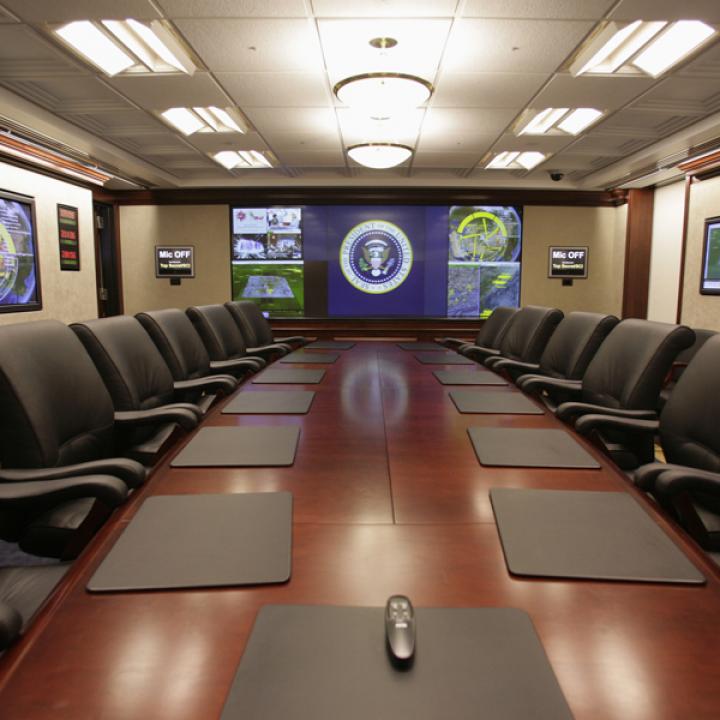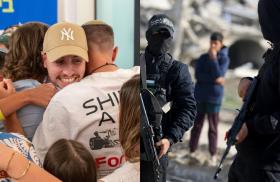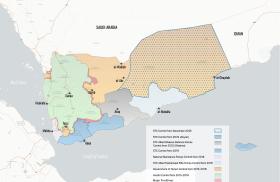
- Policy Analysis
- PolicyWatch 4124
What a Trump Counterterrorism Strategy Should Say

Some of the administration’s counterterrorism actions have diverged from the strategy outlined during the president’s first term and from longstanding U.S. policy, raising important questions that should be addressed in the near future by a second-term CT document.
While the Trump administration has not yet released a second-term counterterrorism strategy, it has already taken major steps to reshape the U.S. government’s CT approach and the wider terrorism landscape, from designating drug cartels as Foreign Terrorist Organizations (FTO) for the first time to revoking sanctions on Syrian jihadists, downgrading efforts to counter violent extremism, and driving an agreement to end the Hamas-Israel war. The previous Trump administration did not announce its counterterrorism strategy until its second year in office. This term, the White House should release the document sooner, which would enable the administration to explain its international CT vision and contextualize how and whether its actions abroad fit into this framework, especially amid dramatic changes in the Middle East over the past two years. This would also send a message that counterterrorism remains a national security priority. In particular, the international aspects of the next U.S. counterterrorism strategy should address the following factors. (Notably, questions about the administration’s domestic CT strategy are important as well but are beyond the scope of this PolicyWatch.)
The Middle East Is Still Central
In 2018, the first Trump administration’s CT strategy document proclaimed that “we are a nation at war,” pointing to global Islamist terrorist groups and Iran as the primary (though not sole) sources of international threats against the United States. Since then, the Middle East has been fundamentally reshaped with the fall of the Assad regime in Syria and the dramatic weakening of Iran, Hezbollah, and Hamas. President Trump is now focusing heavily on the deal he helped broker to end the Hamas-Israel war, painting it as the dawn of a more peaceful and stable Middle East.
Although these developments are certainly promising, the administration’s second-term CT strategy must also recognize that the Middle East remains central to U.S. counterterrorism efforts. The threat of a resurgent Islamic State in Syria and Iraq is still significant and could be exacerbated by U.S. military drawdowns in both countries. Iran and its proxies and partners—including Hezbollah, the Houthis, and Hamas—will undoubtedly attempt to rebuild and strengthen their military and terrorist capabilities, in part to destabilize U.S. and Israeli interests in the region.
The next counterterrorism strategy needs to lay out how Washington plans to mitigate these threats with fewer forces in the Middle East. Will the administration rely more heavily on nonmilitary tools, or will it simply reduce U.S. focus and involvement in the region?
Defining Counterterrorism—and Targeting Cartels?
The new strategy also needs to clearly explain what the administration views as the full scope of counterterrorism. As noted above, the president has broadened the U.S. government’s CT reach considerably by designating numerous drug cartels and gangs in Central and South America as FTOs. These actions raise a number of important questions:
- Are Central and South America now front and center for U.S. counterterrorism efforts and resourcing after decades of being a secondary priority?
- Will counterterrorism resources for the Middle East and other key regions be cut to accommodate these new priorities?
- Will drug cartels and gangs in other parts of the world eventually fall under the terrorism umbrella, or will this approach be limited to the Western hemisphere?
- Bureaucratically, will the U.S. counterterrorism community now take the lead against cartels and gangs, or will this responsibility remain with other entities?
- Are all counterterrorism and military tools now on the table against cartels and gangs, as recent kinetic strikes in the Caribbean suggest?
The new strategy should also lay out what else will fall under the “international counterterrorism” rubric. The 2018 strategy highlighted the threats posed by Islamist groups, Iran and its proxies, and “terrorists motivated by other forms of extremism.” Current administration officials have made clear that Islamist groups and Iran remain high on the list, but they should clarify whether racially and ethnically motivated violent extremism (REMVE) remains a priority. Much of this work was launched during the previous Trump administration, including the State Department’s first-ever designations of REMVE entities in 2020 with the sanctioning of the Russian Imperial Movement. While the REMVE terminology itself may be problematic and overly vague, the transnational threat it describes does in fact exist, which the strategy should acknowledge.
U.S. Global Leadership and Diplomacy
At its core, the new counterterrorism strategy should make clear how it views the U.S. role in leading global CT efforts—a mantle that America has worn with considerable success since 9/11. The 2018 strategy acknowledged that the “United States will continue to lead and provide support to partners in the fight against terrorism,” though it cautioned that America “need not sustain the primary responsibility for counterterrorism activities around the world.”
The current administration has also demonstrated that it understands the vitality of U.S. diplomatic engagement on Middle East issues that affect the CT mission, particularly through its efforts to end the Hamas-Israel war and navigate the aftermath of the Assad regime’s fall. Will this sustained, high-level engagement be reserved for high-profile cases, or will it extend more broadly to U.S. counterterrorism policy throughout the region?
For example, the Global Coalition to Counter the Islamic State, an eighty-nine-member body established by Washington in 2014, is unlikely to remain effective without strong U.S. leadership. Given the potential for a global jihadist resurgence in Iraq and Syria—not to mention the current strength of such groups in Africa—the administration cannot afford to ignore these threats. The United States has also played a central role in the years-long diplomatic campaign to weaken Iran’s overseas terrorism capabilities, from successfully urging other governments to designate Hezbollah and the Islamic Revolutionary Guard Corps (IRGC) to establishing international forums focused on terrorist activity by Tehran and its partners and proxies. The new CT strategy should make clear that Washington—in particular the State Department—will continue to drive this international counterterrorism agenda.
Foreign Assistance
For decades, using foreign assistance and other means to build other countries’ counterterrorism capabilities has been central to U.S. policy. The State and Defense Departments have expended billions of dollars to help other governments detect, interdict, disrupt, and capture terrorists. Despite highly publicized failures like the Afghanistan security assistance mission, there have also been many success stories in which U.S. funding has helped local actors keep terrorist threats from reaching America’s shores.
The 2018 strategy recognized the importance of this line of effort, emphasizing the need to assist U.S. partners in bolstering their understanding of—and ability to handle—such threats. It also underscored that U.S. diplomatic engagement, development assistance, and security assistance were all essential tools in achieving these goals.
The current administration has exhibited a much more skeptical view of all foreign assistance. Accordingly, the new CT strategy should outline whether there are certain types of foreign assistance—particularly on the security front—that the administration values as essential components of the U.S. counterterrorism mission. Leaving other countries to handle these threats on their own is certainly not a good recipe for U.S. security, in part because it could come back to hurt the homeland.
This issue is particularly salient in the current context of heightened Gaza diplomacy, affecting plans for both reconstruction and security. President Trump’s twenty-point plan states that “a temporary International Stabilization Force” will “train and provide support to vetted Palestinian police forces in Gaza” in consultation with Egypt and Jordan. Historically, the United States has been a major funder and trainer of Palestinian forces. The next CT strategy document should make clear whether the current administration is interested in continuing this role—and, if not, what specific international alternatives it proposes to fill the gap left by the absence of American assistance.
Countering Violent Extremism
With the elimination of the State Department’s CVE Office, the dismantlement of the U.S. Agency for International Development, and the cancellation of many Department of Homeland Security grants, the next CT strategy will need to clarify whether counterradicalization programs and broader terrorism prevention efforts will be part of the administration’s CT agenda. The 2018 strategy prominently featured this line of effort. After noting that the United States had “not yet developed a prevention architecture to thwart terrorist radicalization and recruitment,” it warned that America “will be fighting a never-ending battle against terrorism” unless it took steps to better address these gaps.
To be sure, there are many valid criticisms of existing CVE and prevention efforts, including the difficulty of gauging and demonstrating success. Yet that is hardly a reason to give up on the entire CVE enterprise, and the next CT strategy should emphasize this point. In Gaza, the Trump peace plan calls for “deradicalization” and other CVE-type prevention and rehabilitation efforts, making it all the more vital to clarify the scope of such programs.
Conclusion
The Trump administration’s first nine months of counterterrorism actions suggest that it is adopting a markedly different approach compared to the president’s first term. Releasing its next CT strategy document sooner rather than later would help clarify the extent to which these changes represent a new direction, and indicate where officials see the counterterrorism fight headed over the next three years.
Michael Jacobson recently rejoined The Washington Institute as a senior fellow in the Reinhard Program on Counterterrorism and Intelligence after serving in the State Department’s Counterterrorism Bureau from 2010 to 2025, most recently as director of strategy, plans, and initiatives.



